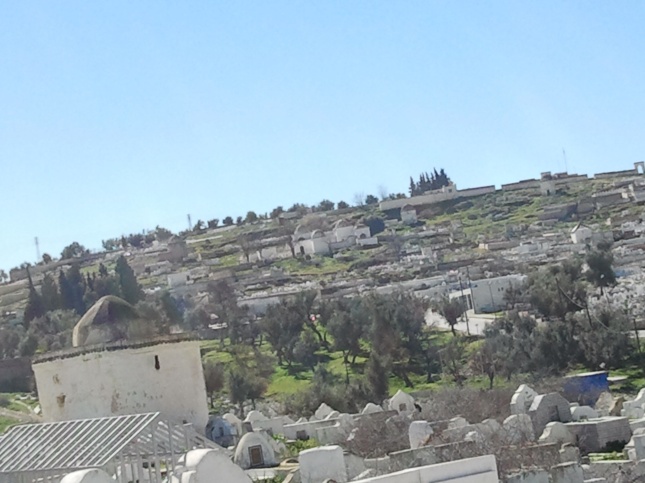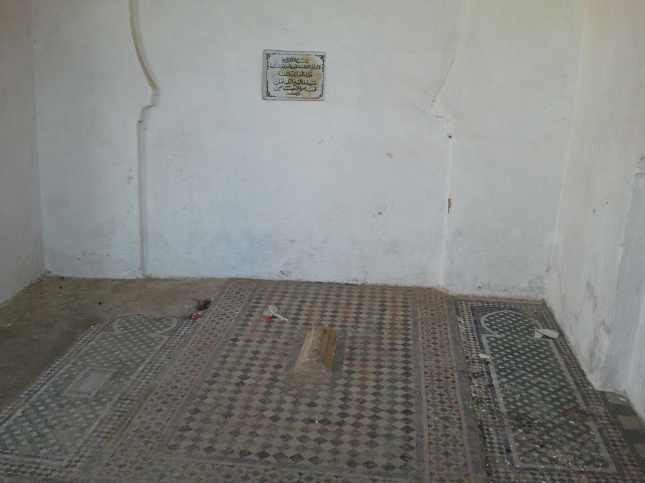Ibrahim Afaaham
Sidi Ali As Sanhaji Ad Dawwar
Abderrahmn Al Majdoub
Yusuf al Fassi
Abderrahman Al Fassi
Mahmed bin Mahmed bin Abdullah
~Qaasim Al Khasaasi~
Ahmed bin Abdullah
Al Arabi bin Ahmed bin Abdullah
Sidi Ali Al Jamal
The Master, Ad Darqawi
The following translation from Salawat al Anfas discusses the life of Qaasim Al Kasaasi, Master of the Shadhili Darqawi silsila, and one of the seven blessed saints to be buried at the Kubbah of the seba’atu rijaal of the bab al futuh graveyard. His tomb rests at the far right corner of the Kubbah. For detailed instructions on how to get to the tomb: please await a forthcoming map, which will detail in full where he and all the other saints of the bab al futuh graveyard are to be found…
Al Shaykh Al Murrabi Sidi Qaasim bin Qaasim al Khassasi
(D: 1083)
The shaykh, the Imam; the valiant Gnostic; the spring-source of Tawhid; the treasure trove of divestment and singling-out; the overflowing see of Gnosis; the down-pouring, streaming-shower of aid from Allah; the perfect, realized and arrived master; The closely drawn and fully absorbed Majdoub; Author of lofty subtle insinuations ( isharaat); possessor of the Truths of the Sunnah and the states of Divine Ecstatic Love; The Emanations of Gnostic ( Wisdom); the Malamati; Abul Fadl Sidi Qaasim bin Al Hajj Qaasim bin Qaasim Al Khasaasi. By that ( Al Khasaasi) he became known. He was Andalusian by his roots, and Fassi by residence, birth, rearing and burial.
Regarding our saying ” Khasaasi”: it is in relation to” Khasaasa”, which was a city on a beach by the sea, at the foot of the Djebel Qali’a, which has been covered over by salty and fresh water, and so there are no buildings there today. There, his predecessors resided, and they used to hold a place of fame there for their stations of Wilayat. For one of them – being, sidi Masud Al Khasaasi – there remains a shrine ( where their grave is). After the abandonment of the city, the departed from it; first to the aforementioned mountain to the rear of it, then later to Fes. They say about him that he once said, ” We are from Andalusia. That was where our predecessors used to be before their coming to (Djebel) Qali’a”.
He was born – May Allah have mercy on him – somewhere within the range of 1001 or 1002, and he was raised entirely in the care of his mother, for his father died and left him ( while he was) in his mothers belly. So like that he was raised until he reached adolescence and his full manhood, at which time he began to have sensual desires for and an ( indecent) intermingling with the young women his age of the families in the neighborhood and outside of it, which he later used to mention while recounting what proceeded from him ( of regretful actions) on account of it.
Then, there blew over him the sentiments (of a sincere) repentance ( and regret for his actions), so he took recourse to the grave of Shaykh Abil Mahaasin Yusuf Al Fassi, without intending for it, for he did not know about the grave nor the name of who was buried in it. He called out to it saying, ” Oh Companion of this grave! If you were truly a Wali of Allah, then I seek from you that Allah would gather me together with a shaykh that I can serve for the sake of Allah, and who has no one serving him other then me.” After that, Allah did indeed gather him together with his first shaykh, and he was; Sidi Mubarak bin ‘Abaabu Al Kosh ( buried outside bab Guissa). So Qaasim served him for a time until his death; then, he attached himself after that to the gnostic Sidi ( Abderrahman ) Al Fassi, and it was from him that he wrested his desire, and at his hands that he had his grand opening. He remained in his companionship with the shaykh for around ten years, and the shaykh used to say to him, ” You are mine and not for anyone other then me!” Insinuating to – and Allah knows best – that his opening came at the shaykh’s hands and none others. He used to say also, ” You are peculiar: you have no brother.” Insinuating to – and Allah knows best – that he was: peculiar in his wayfaring and his gnosis and his ( degree of ) realization.
Then, after the death of his shaykh; He accompanied his Khalifa and Inheritor, Sidi Mahmad bin Abdullah al Ma’in Al Andalusi, and in his companionship he remained for another twenty six years. Those were the three shaykhs upon which he relied, and from whom he wrested the object of his desires, as he listed himself and was heard directly from from him, ( listed off) one by one.
They also say: He met twenty six shuyukh, or around that many, but was the inheritor of his final shaykh, Sidi Mahmad bin Abdullah. Of that, we are informed by his student, who was also the son of his aforementioned shaykh: Sidi Ahmed bin Abdullah. It says also in ” Al Maqsud”: ” One day he ( Ahmed bin Abdullah) sat with the companions of his shaykh after the passing of his shaykh ( Mahmed bin Abdullah) as they were discussing among themselves, at a loss; ‘how are we supposed to know who his inheritor was?’. Sidi Qasim was with them at that time, and said to them: ‘ Here is the beast right in the midst of you, but where is he who can extract him and discern him?'”
He was – may Allah have mercy on him – one of the people under Lordly care and protection, and luminous states, and absence in the unity, and total absorption in the sea of realization. He was strong in his states, abundant with light, and overflowing in ( divine) aid. The state of absence would overtake him, and it became normal for him that it would increase over a period of around five days every month, in which he would not be able to distinguish the ground from the sky, nor would he eat or drink, except that he would ( come to his senses enough) to ask about the times of prayer every hour, though ( even when so) he would indeed ask about the daytime prayers even after nighttime had come. When that happened to him, he would not exit his house. His Tariqah was: love and annihilation in the unity. He would not indicate, in his speech, except to those two things, nor would he turn to anything else but those two things. By way of them, he encouraged the people to ( seek) Allah, and he paid no attention to the path of Fear and did not indicate as to it. He did not like people to stop with witnessing fear and what was similiar to it, out of fear that they themselves would fall short on account of it from rising to Allah.
He used to become very excited and stirred up by the Samaa’, and rise up standing in the throngs of wajd ( ecstatic love) while yet short of dancing ( as they did), and he would seek out and associate with the people of Samaa’. He was strict in firmness in matters of the Din and following the sunnah, very high minded, cutting-off from the lower world and its people, at the uttermost extreme in asceticism and scrupulousness, and few in possessions. He would eat from the work of his own hands, and made trade in a shop he owned ( for his provision). He would not accept anything from anyone, even from his companions, excepting for Sidi Ahmed bin Abdullah. He also had a great love for the family of the prophet, and was greatly glorifying of them.
He had many miracles and numerous unveilings, as well as great dispositions of character, some of which are mentioned in ” Al Maqsud” and ( some in ) other then it. He saw Al Khidr – alayhi as salaam – and informed the people of the news of that meeting. In spite of that, he had such escapades and blame-worthy ( really, blame-seeking) acts that the people who did not know the reality of them and were not partners with him in his ( lofty) state used to censor him for their outward form. ((” …and none understand them except the knowledgeable”)) (Al ankabut: Surat 44)
And among his Escapades and Miracles are: what they report of him, that he was one day sitting in his shop with his head inclined, sowing, as was his norm, when suddenly a very great rain began to fall. They people waited for him to finish what he was doing ( and flee to safety) in time, but he continued as he was without concern. Then, he stood up and raised his head to the sky and said in anxiety, ” What will suffice us from this rain!” In a manner as one would when addressing an intimate: and the rain was cut off in a moment as if it had never been – at which point he came back to his senses repenting for what had proceeded forth from him – may Allah be pleased with him and benefit us by him.
His stations and his states were many, and his miracles great and famous, and it suffices (in evidencing) the loftiness of his rank and the greatness of his glory that Sidi Ahmed bin Abdullah reached completion at his hands, and accomplished his spiritual upbringing and refinement by him.
It says in, ” Al Maqsud” : ” I have commissioned a vow to publish a book specifically about him; from his miracles to everything other then that regarding him. I have made the intention to name it upon its completion: ‘ Bil Zahr al baasim fi Akhbaar al shaykh Sidi Qaasim’ may allah ease ( the way for) its completion by his graces and favors” . However, divine decrees did not assist him in completing it; rather, the times and the stability ( of the country) prevented him from completing it, so he delegated the task to his grandson, the learned scholar Abu Abdullah Sidi Muhammad ibn Al Tayyeb Al Qaadiri, who mentioned his glorious exploits and states in the publication of a more moderate book, which he named ” Bilzaahir Al Baasim” or ” Al Arf Al Naasim, fi Munaaqib shaykh sidi Qaasim, wa Ma’thaar man lahu min al ashiyaakh wal atibaa’ ahl al mukaraam”. In it, he summarized the accounts of him into eight chapters; so whoever wished to read ( about him), then let him read it.
He died – may allah have mercy on him and be content with him – in the middle of Sunday night on the nineteenth of Ramadan, most agreeing in the year 1083 or around 1082. He was buried in the rawdat of his shuyukh in the highest locality of the garden, facing the Kubbah ( dome) of the shaykh Mahmad bin Abdullah Ma’in, infront of him. They built over him a building; and this was at the hands of his student sidi Ahmed bin Abdullah. His grave there is well known unto today, upon it is a darbouz that the people visit and seek blessings from. His biography is in ” Al Maqsud” and ” Al Safwa” and ” Al Rawd” and ” Al Nashr”…and other then them.

